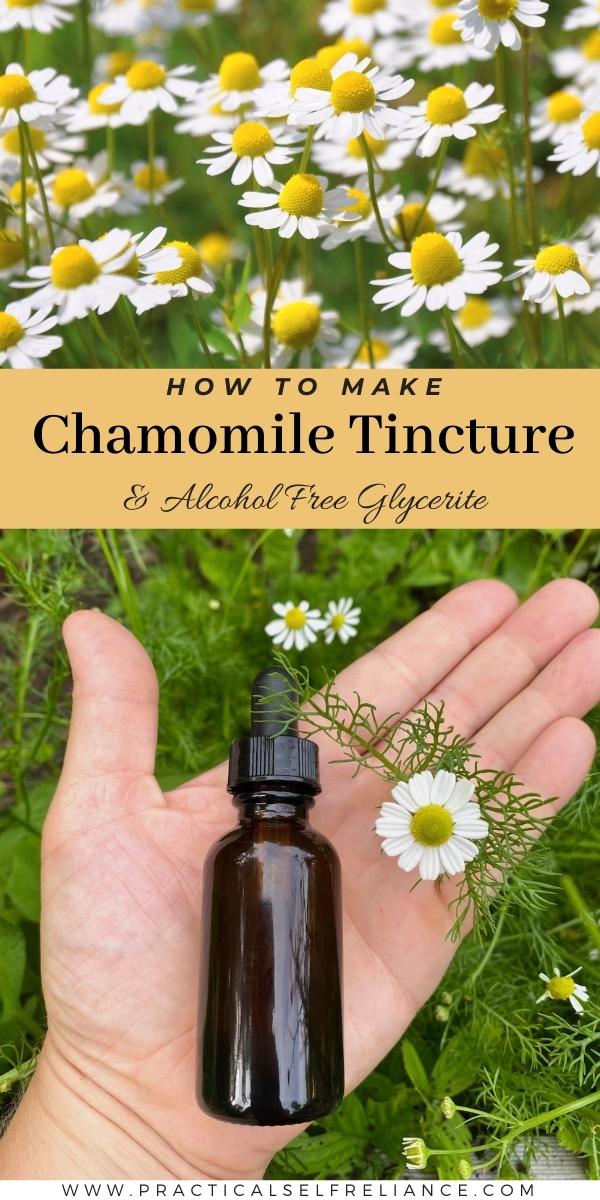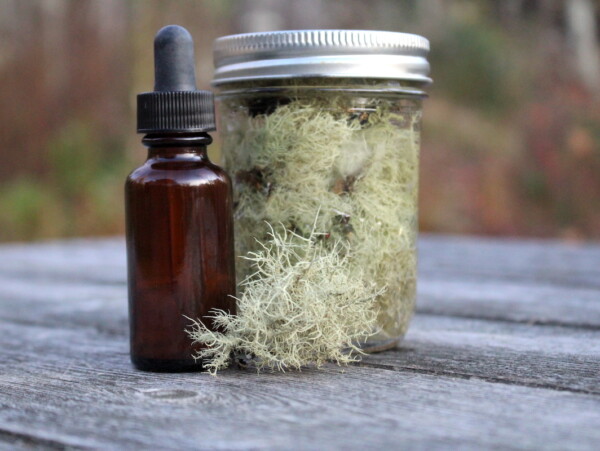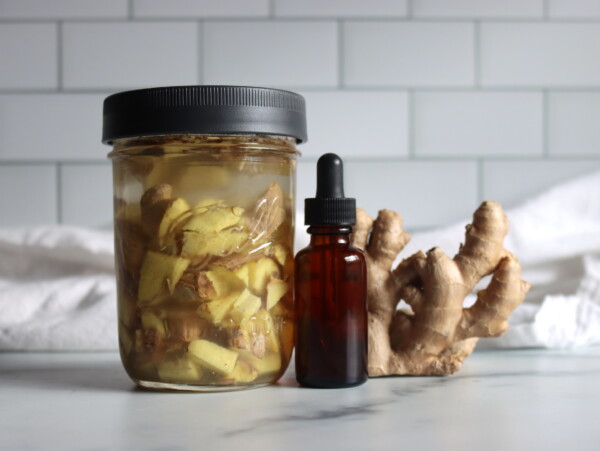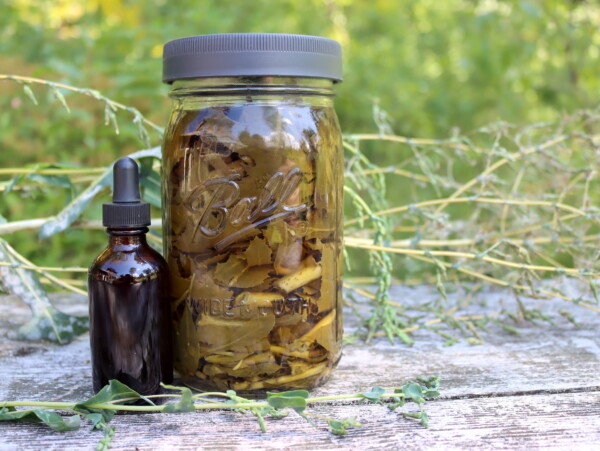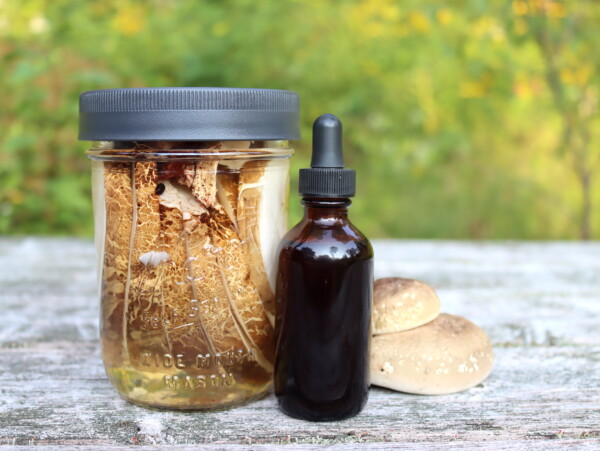Affiliate disclosure: This post may contain affiliate links. Please see our Privacy Policy.
Chamomile tincture is a gentle herbal remedy for insomnia and anxiety in adults, as well as teething, fussiness, and colic in children. When used externally, it can also treat skin irritation and it’s a natural antimicrobial.
It’s easy to make at home with just a few simple ingredients!
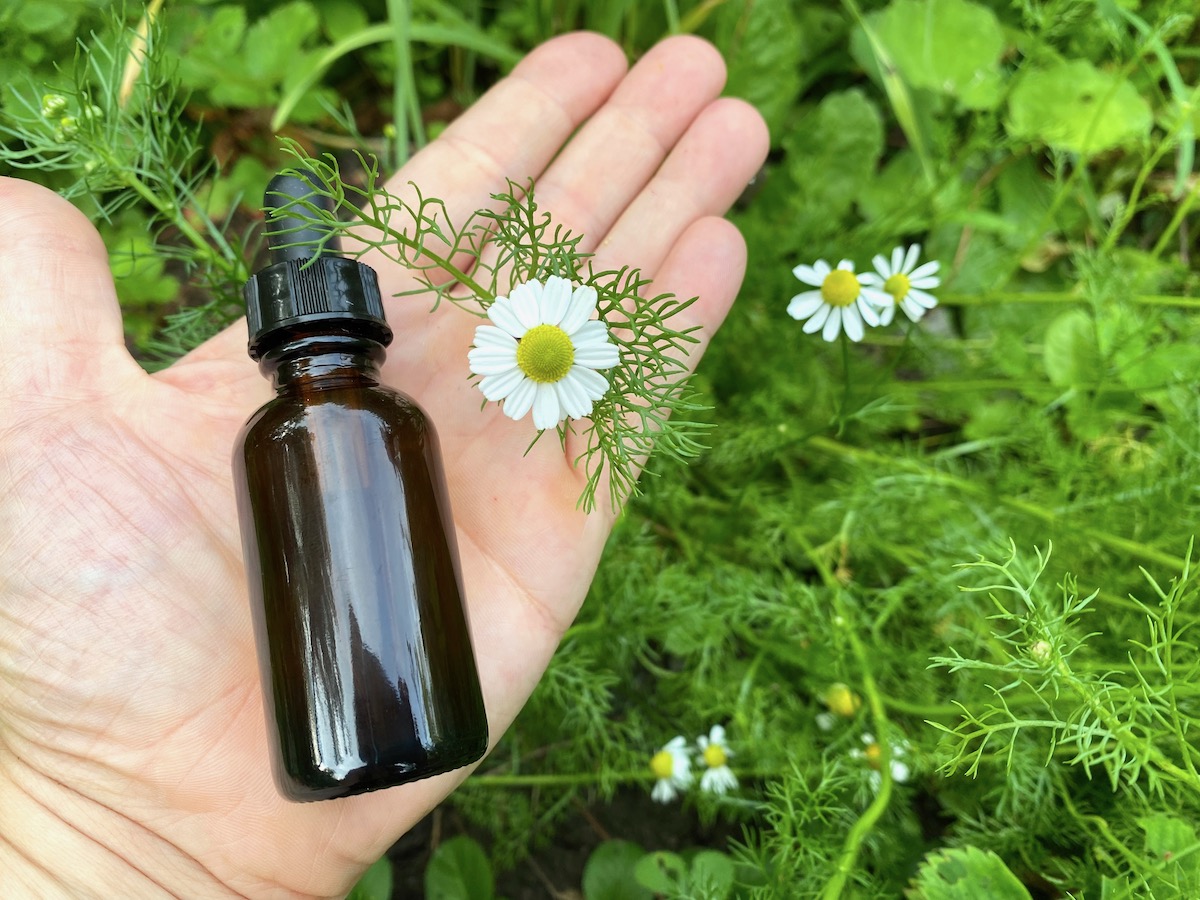
Chamomile tincture is a simple herbal extract that concentrates the benefits of chamomile into a shelf-stable extract that’s ready just when you need it.
Herbal tinctures are usually made with alcohol (like vodka) for adults, but they can also be made with food-grade vegetable glycerine for children. In that case, they’re called herbal glycerites, but the process is pretty much the same.
Herbalists often suggest chamomile glycerite to ease the inflammation and discomfort associated with teething in toddlers, and this gentle calming remedy can also help with colic and hyperactivity.
In adults, chamomile tincture is usually used internally for stress, anxiety, and insomnia. Since it’s a relaxing anti-inflammatory, it’s also been shown to be effective as a treatment for menstrual cramps as well.
Externally, chamomile tincture is used as a topical antimicrobial agent, and to soothe skin irritation. In that case, it’s generally an alcohol-based tincture (since glycerites aren’t the best for topical use).

(Always consult your doctor or a clinical herbalist before trying any new herbal remedy, as there’s always the possibility of unintended consequences, allergic reaction, or interactions with other medication. If you’re harvesting wild plant material, make sure you’re 100% confident in your identification and consult multiple sources for your ID. The following is based on my research and experience, but I don’t claim to have any certifications that would qualify me to advise you on your health. Please do your own research and always verify with multiple reputable sources.)
Benefits of Chamomile Tincture
Chamomile tincture has been taken as a sleep aid for hundreds of years, a usage that has now been backed by modern science. But while chamomile is probably best-known for its mild sedating effects, did you know it also has powerful anti-inflammatory and antimicrobial properties?
When chamomile tincture is used as a mouthwash, it has been shown to alleviate the painful burning sensation associated with mouth ulcers. Chamomile has traditionally been used for its anti-microbial and anti-inflammatory properties, particularly in the form of a mouthwash.
Another small study found that chamomile showed some promise for its ability to reduce oral inflammation for those suffering from chronic gum disease.
Chamomile has been studied for its wound-healing properties.
When applied externally, one study concluded that the application of chamomile extract after tattoo removal had a significant drying effect on the area (which helped to prevent further wound weeping and infection).
Chamomile extract has also been shown to help heal some of the painful itching and flakiness associated with eczema — in fact, one small study found it to be about 60% as effective as 0.25% hydrocortisone cream (but without any of the skin-thinning side effects associated with long term hydrocortisone usage).
Chamomile extract has also been shown to have benefits when it comes to reducing menstrual cramps. In one study, participants were asked to drink two cups of chamomile tea one week before the beginning of their menstrual cycle and then for the first five days of their cycle. In comparison to the control group, it was found that chamomile helped alleviate cramping in addition to anxiety and low mood.
Tincture and tea are different herbal preparations, of course, but it’s likely the effects are similar.
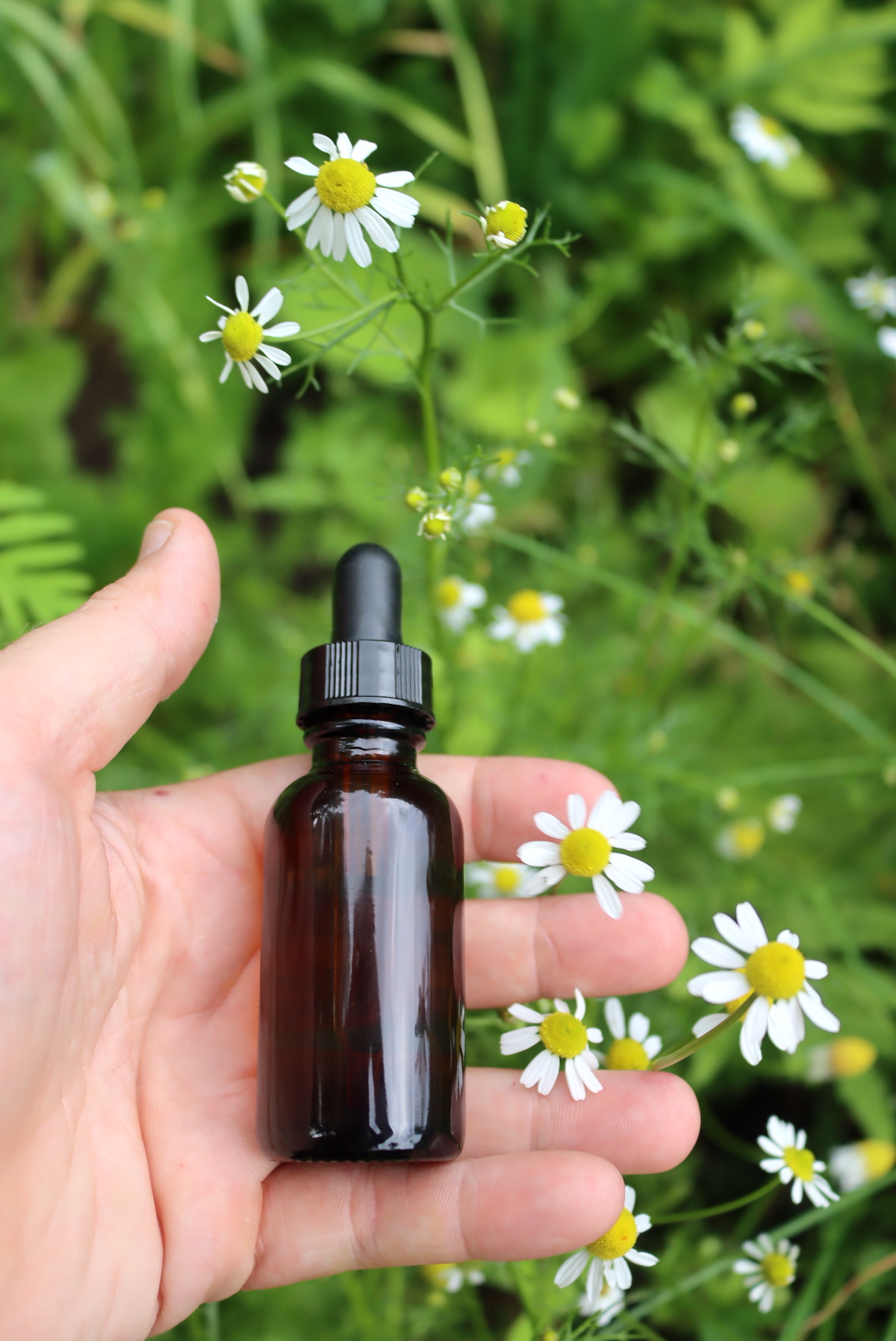
How to Make Chamomile Tincture
To make a Chamomile tincture, you’ll need the following ingredients and equipment:
- fresh or dried chamomile flowers (Fresh can come from your garden, for dried chamomile, I’d recommend either Mountain Rose Herbs or Starwest Botanicals)
- Vodka (or any other palatable alcohol that’s at least 80 proof/40 percent — there’s no need to splurge here, I always use Smirnoff because it’s inexpensive and has a neutral taste)*. To make an alcohol-free chamomile glycerite, substitute food grade vegetable glycerine for vodka in this recipe.
- One-pint mason jar with lid (amber glass is ideal, but as long as you keep the tincture away from light at all times it won’t make a difference)
- Funnel
- Cheesecloth
- Fine mesh sieve
- Amber glass tincture bottles (with dropper)
*Never use isopropyl/rubbing alcohol for tinctures (or any other remedy you plan on ingesting). Even in small amounts, this type of alcohol is toxic and meant for external applications only.
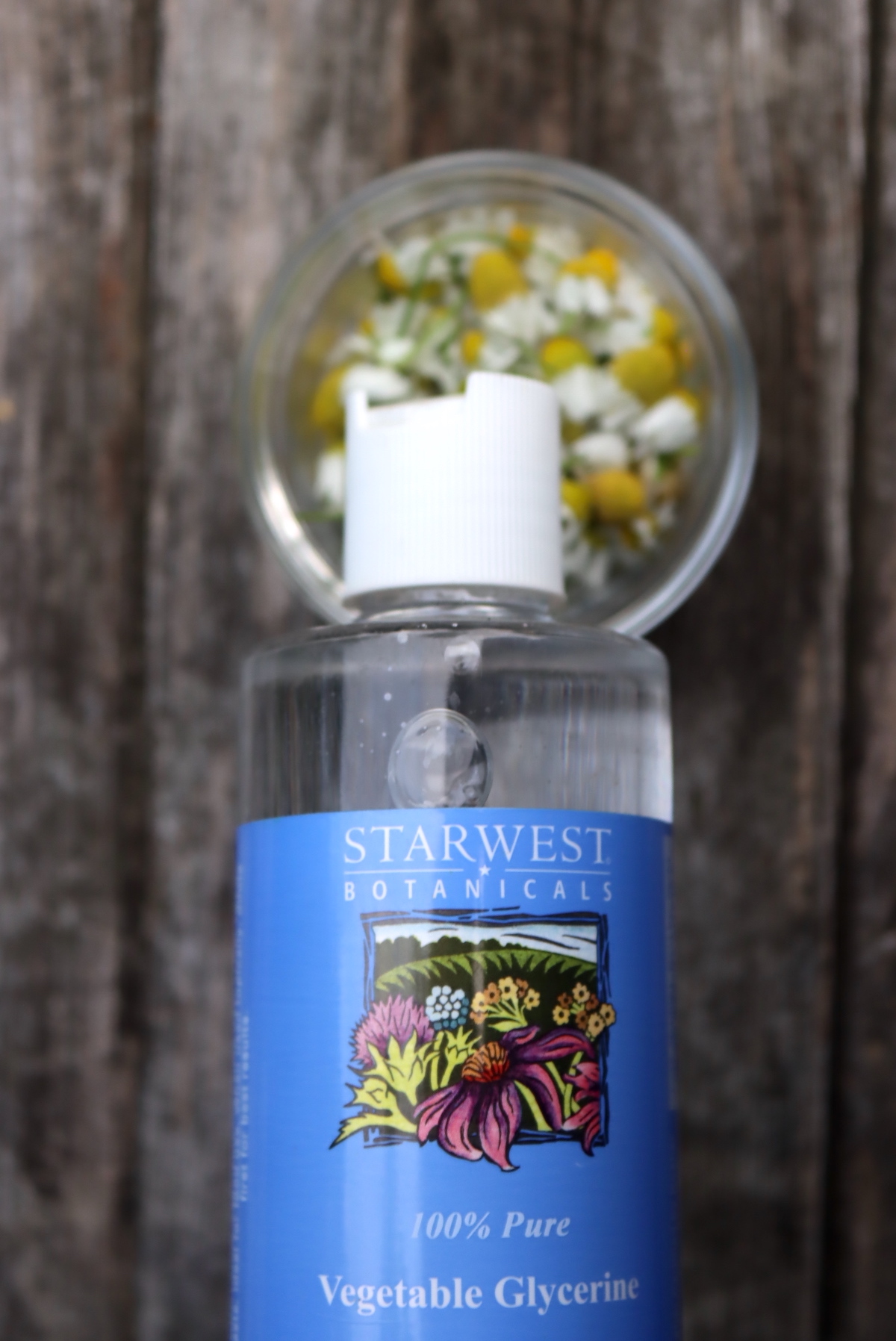
To make the tincture, add fresh or dried chamomile flowers to a clean mason jar (pint or quart). With fresh flowers, fill the jar about 2/3rds full. For dried, aim for about 1/3 to 1/2 way full.
Cover the chamomile with vodka (or whichever alcohol you’ve chosen whisky, brandy, etc) or glycerine, and seal the jar with its lid.
Keep the developing tincture in a cool, dark place and give the jar a gentle shake every few days (daily is even better, but tinctures are, fortunately very forgiving when it comes to precise shaking schedules).
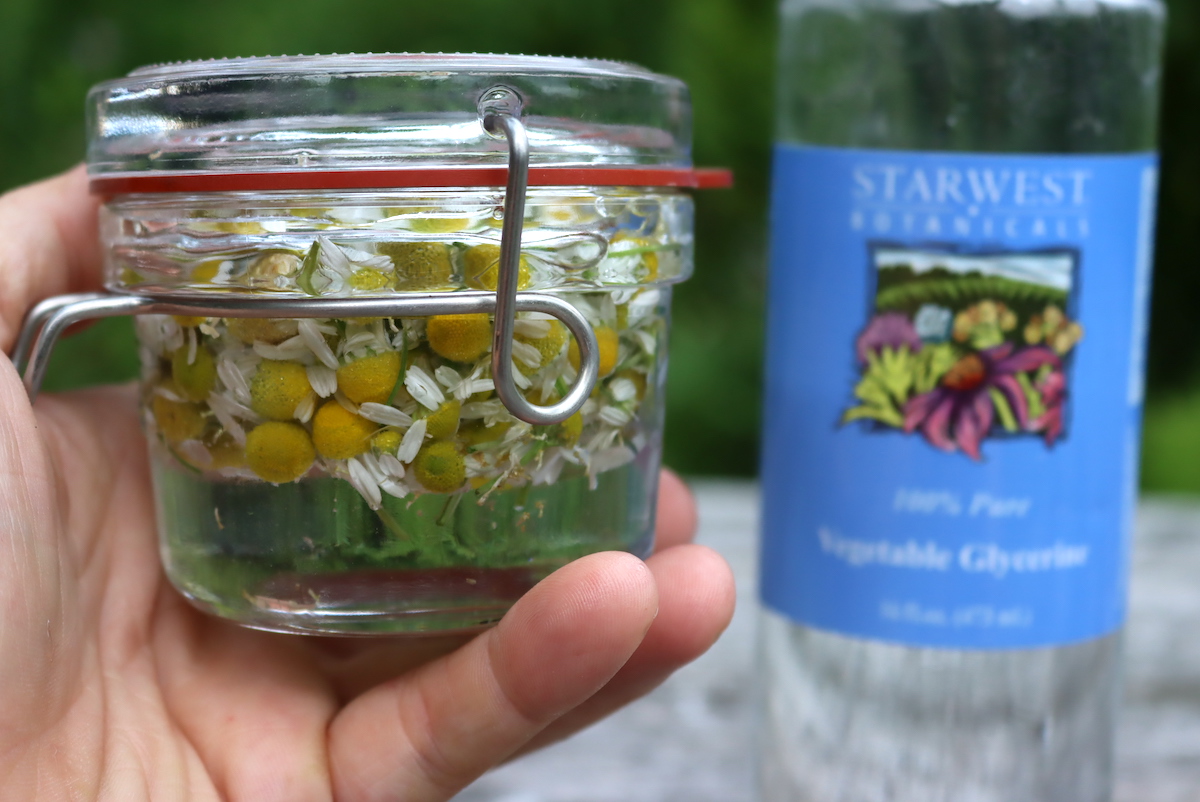
After about 4 to 6 weeks, it’s time to decant the tincture or glycerite.
To do this, you’ll need to line a funnel with a few layers of cheesecloth. Carefully strain the tincture into small amber glass tincture bottles, squeezing the flowers to make sure all the liquid comes out.
Chamomile flowers tend to absorb alcohol readily, so you want to squeeze them to get every last bit out so it doesn’t end up in your compost pile.
Once the tincture has been decanted, label the tincture bottles with the date and suggested dosages (I use a small piece of masking tape and a marker, it peels off easily when I’m ready to use the bottle for something else).
For more information on the general process, I’d suggest reading this guide to making herbal tinctures at home.
I know 4-6 weeks can be a long time to wait if you’re desperately needing chamomile tincture or glycerite now. There’s nothing wrong with buying a bottle of chamomile tincture or alcohol-free chamomile glycerite to use while your homemade tincture infuses. Purchased tinctures are a lot more expensive than DIY homemade ones, but they have the benefit of being ready when you need them, like now.
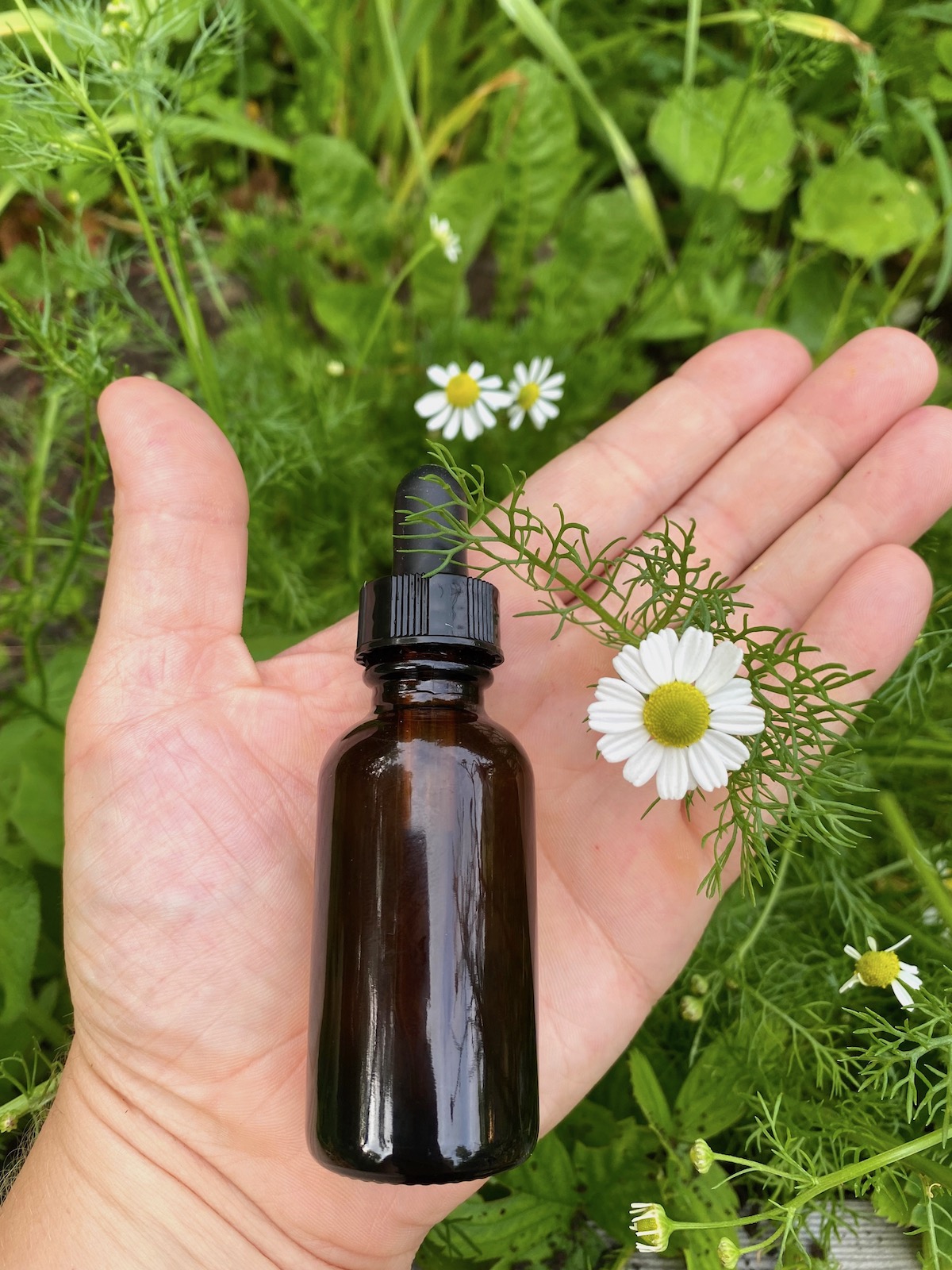
Chamomile Tincture Dosage
For an exact dosage specific to your body and needs, I’d suggest consulting a clinical herbalist.
The dosage for chamomile tincture varies depending on its intended use and age of the person taking it, but anywhere from 2 to 5 dropers is considered standard (the higher dosage is typically taken for sleep and relaxation).
Chamomile Formulations
Chamomile is usually combined with lemon balm and lavender tincture for gentle, stress-relieving, and sleep-promoting formulations. Those are also good additions for gentle glycerites.
Personally, I love combining it with valerian tincture to improve sleep, since both herbs have complementary uses. Valerian is incredibly effective but has a strong flavor, and mixing it with chamomile tincture makes it a bit easier on the taste buds.
If you’re interested in the science behind combining herbs to enhance their effectiveness, I’d recommend taking this online course in Mastering Herbal Formulations from the Herbal Academy. It covers the science of blending herbs into homemade formulations in detail.
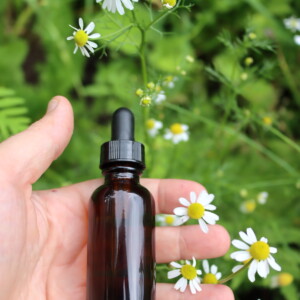
Chamomile Tincture (& Alcohol Free Glycerite)
Equipment
Ingredients
- Fresh or dried chamomile flowers
- Vodka or other high-proof alcohol *see notes for making a glycerite tincture
Instructions
- Begin by selecting either fresh or dried chamomile flowers. Fresh flowers should fill your mason jar about halfway, while dried chamomile will fill it a bit less, roughly one-third of the jar. The more compact the flowers, the less liquid you will have after extraction, so aim for a loose pack that allows room for the alcohol to permeate.
- Pour your chosen high-proof alcohol over the chamomile flowers. Vodka is a common choice because of its neutral flavor, but you can also use brandy or rum if you prefer a slightly different taste profile. The goal is to fully cover the flowers with alcohol, ensuring they are submerged by at least 1 to 2 inches to avoid exposure to air, which can cause mold.
- Secure the lid on the jar tightly, and give it a good shake to mix the flowers and alcohol. Then, place the jar in a cool, dark spot, such as a cupboard or pantry. Let the chamomile steep in the alcohol for 4 to 6 weeks, allowing the tincture to develop its soothing properties.
- For the best extraction, gently shake the jar every 1 to 2 days. This helps ensure the flowers are evenly submerged and the tincture is extracting effectively. If you're using fresh chamomile, you may need to check that the flowers stay fully submerged, as fresh herbs tend to float. Add more alcohol if necessary.
- After about 4 to 6 weeks, strain the tincture through a fine mesh strainer or cheesecloth into a clean glass bottle. Press the plant material to extract as much of the liquid as possible. Discard the used flowers, as they’ve already given up their medicinal properties to the tincture.
- Label your tincture bottle with the date of preparation, the contents (Chamomile Tincture), and any dosage or usage notes. Store it in a cool, dry place, away from direct sunlight. Chamomile tincture will keep for several years when stored correctly.
Notes
Expected Yield
Fresh chamomile flowers will release some moisture into the tincture, so you'll likely end up with a little more liquid than you initially add. Dried flowers will absorb some of the alcohol, resulting in a slightly lower yield. For a quart jar, you’ll typically need about 2 to 3 cups of alcohol, or about 1 to 1.5 cups for a pint jar. Make sure the chamomile flowers stay submerged throughout the extraction process for the best results.Alcohol-Free Option: Glycerite
If you prefer a non-alcoholic option, you can create a chamomile glycerite tincture using vegetable glycerin instead of alcohol. For this method, cover your dried chamomile with a 3:1 mixture of glycerin to distilled water. If you’re using fresh chamomile, you can skip the water and use all glycerin. Shake the jar daily and strain it after 6 to 8 weeks, just as you would with the alcohol-based tincture. Chamomile glycerite is one of the most common types of alcohol-free tinctures since it’s commonly made for and given to young children. Since it’s especially popular with teething or fussy infants, having an alcohol-free version can be extra helpful for the little ones in your life. Of course, always ask your pediatrician before trying any new remedy, herbal or otherwise.Disclaimer on Homemade Herbal Remedies
I’ve been foraging wild medicines and treating my family with herbal remedies for the past 20 years, but I’m self-taught. Be aware that I am not a clinical herbalist, and this is based on my own research and personal experience using medicinal plants. I do not claim to have the experience that’d qualify me to advise you on your health, and I’m only providing this as a reference to encourage a broader interest in medicinal plants.
Please use this as a jumping-off point, but always do your own research and verify anything you read with multiple sources.
It’s always possible to have an adverse reaction to any medicinal herb, and plenty of people are allergic to even gentle herbs like chamomile. Always consult your doctor or a certified herbalist before trying any new medicinal plant. Often, they can have unintended reactions in combination with other herbs and supplements, and many herbs have side effects even when they are effective for their intended purpose.
If you are seriously interested in herbal medicine, I’d suggest investing in a course in herbal medicine, and I’d recommend any of the online courses put out by the Herbal Academy of New England. Specifically, the introduction to herbal medicine course and the family herbalist group of courses.
They also have a mushroom course, covering both medicinal and edible mushrooms, and a Botany and Wildcrafting Course. I’ve taken both and they’re informative, inspiring, and artfully presented.
Herbal Tinctures
Interested in making other homemade herbal tinctures?
- Yarrow Tincture
- Chickweed Tincture
- Elderberry Tincture
- Dandelion Tincture
- Burdock Tincture
- Echinacea Tincture
Herbal Medicine Making
Herbal medicines don’t stop at tinctures! Learn how to make more homemade medicine…
